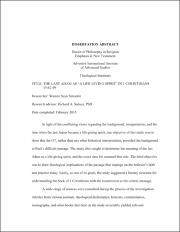| dc.description.abstract | In light of the conflicting views regarding the background, interpretation, and the
time when the last Adam became a life-giving spirit, one objective of this study was to
show that the OT, rather than any other historical interpretation, provided the background
to Paul’s difficult passage. The study also sought to determine the meaning of the last
Adam as a life-giving spirit, and the exact time He assumed this role. The third objective
was to draw theological implications of the passage that impinge on the believer’s faith
and practice today. Lastly, as one of its goals, the study suggested a literary structure for
understanding the book of 1 Corinthians with the resurrection as the central message.
A wide range of sources were consulted during the process of the investigation.
Articles from various journals, theological dictionaries, lexicons, commentaries,
monographs, and other books that bear on the study invariably yielded relevant
information which contributed to the development of the dissertation and ultimately to
the conclusion reached. An exegetical study of the passage using the historicalgrammatical
method was undertaken to achieve the goal. The actual sifting of the text
used such literary devices as comparative frames, natural information flow, the use of the
coordinating conjunction ἀλλα, key words and phrases (e.g. πνευμα, ψυχη, ζωή, πνεῦμα
ζῳοποιοῦν, γράμμα ἀποκτέννει, and πνεῦμα ζῳοποιει), and intertexuality.
The study identified seven arguments in support of the OT as the appropriate
background of the text. The argument from grammatical parallels, the argument from
theological continuity with the OT faith on life after death, and the argument from
theological discontinuity with other historical interpretations supported the OT
background. Other points in favor of the OT included the argument from Paul’s own
historical background, the argument from his use of Scripture, the argument from the
linguistic difference in the usage of some terms, and the argument from methodological
differences between Paul and other historical interpretations.
For the meaning of the last Adam as a “life-giving spirit,” the study spoke for the
risen Christ. The grammar, the context, and other interpretive devices favored this view.
However, it was recognized that there is a sense in which the Holy Spirit plays a role in
the Pauline passage, especially in the transformation of hearts and the building up of the
eschatological body of Christ. Creative energy as an option was completely rejected
unless it is connected to a divine being. Finally, theological implications covered such
themes as protology, anthropology, ecclesiology, missiology, and eschatology. | en_US |

